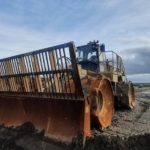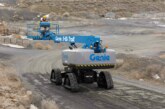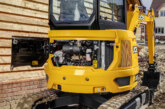Adam Walker, Engine and Drivetrain Product Manager at Finning, exclusive dealer of Cat equipment and parts in the UK & Ireland, provides an insight into why more companies are choosing to have a machine rebuilt instead of buying new.
The waste and demolition sectors are shedding their dirty images as they push ahead to implement more sustainable practices. It’s no surprise therefore that companies are looking at alternative options when it comes to their fleet machinery – with demand for rebuild machines beginning to grow in popularity.
There’s been a significant shift over the last decade or so in the waste and demolition sectors as we see them transition to become more sustainable. The waste industry for example has evolved to focus less on waste per se, instead seeing it as a resource that can be recovered, reprocessed and reused where possible. This circular approach significantly reduces emissions generated by landfills and reusing materials instead of manufacturing or extracting new, as well as generating wider environment impacts. The demolition sector is going through its own transition now known as deconstruction, which prioritises extraction and removal of components and materials so they can be reused elsewhere instead of ending up in landfill or being incinerated.
With sustainability now at the fore of these industries we’ve seen a shift in demand for a similar approach to fleet machines with companies requesting not just remanufactured or reconditioned parts for their machines, but for the entire machine to be rebuilt.
It’s well known that Cat machines are built to be rebuilt, with some machines having the capacity for a second, third or even fourth life. Over the last few years this is an area we’ve seen significant growth in. Between 2019 and 2021 we have seen the number of machine rebuilds double year on year – with the specialist rebuild engineers completing just under 220 over the three-year period. During the first half of this year alone, the team of service engineers have already clocked up more than 110 rebuilds across the company’s five rebuild, repair and response facilities located in Cannock, Leeds, Glasgow, Llantrisant and Dublin
Most of the rebuilds have been carried out for companies working in the quarrying and aggregates sectors who have chosen to have their heavy-duty off-road trucks or dozers given a new lease of life. For example, we’ve recently completed a full rebuild of a Cat D9 dozer for Stokey Plant Hire, one of the UK’s largest suppliers of material handling and earthmoving services. The firm originally purchased the machine from Finning in 2007 and towards the end of 2021 decided to go ahead with a certified powertrain (CPT) rebuild rather than purchasing a new dozer. This was the first rebuild that they had commissioned and have been so impressed with the quality and performance they’ve already commissioned additional similar projects.

We’re seeing increasing demand from companies in the waste sector, as sustainability becomes embedded in the way they operate at a commercial level – and so they can meet their own customers’ green credentials. We recently worked with the NWH Group, one of the UK’s leading recycling and waste management businesses. Their mission – to change the industry for the benefit of the planet – illustrates a clear rationale for choosing to have two of their Cat 950M wheel loaders rebuilt when they reached the end of their operating life, instead of buying new machines.
Sustainability
Rebuilding a machine is by far the most sustainable choice. If we look at the environmental impact of manufacturing a new cylinder head compared with using a remanufactured one, it generates 61% fewer greenhouse gases, requires 85% less energy and uses 86% less water. A remanufactured cylinder head also requires 85% less material than a new manufactured product and means there’s 85% less waste being sent to landfill.
A large proportion of the parts removed from the original machine are recovered, restored, and reused as a standard part of the rebuild process – creating a circular economy of sorts. Any new components and parts for the rebuilt machine, such as the engine and hydraulics, are sourced through a combination of remanufactured parts fully certified through Caterpillar, via the Finning parts service exchange programme, or bought new.
Better value for money
Customers choosing a rebuild machine option will typically save around 55-60% on the cost compared with buying a new machine, which can be significant across an annual CAPEX spend. In Stokey’s case, the total investment on the D9 was just under £300,000 which is significantly less than what it would cost to buy a brand-new equivalent machine.
Availability
The industry is facing many challenges, one of which is lengthier lead times for new machines and equipment – an issue that’s affecting all machine manufacturers and suppliers. Choosing to rebuild a machine is a viable alternative and gives customers an additional option when they’re looking at renewing or replacing equipment in their fleets. The length of time it takes to rebuild a machine varies according to the scope of the work and can be dependent on the availability of reconditioned and remanufactured parts.
The duration of a rebuild, as is the case for Stokey, can be minimised by carefully planning the availability of any reconditioned or new components so that there is limited downtime on the rebuild.
An important part of sustainability plans
The team of engineers at Finning HQ in Cannock is currently working on a certified Machine rebuild (CMR) of a Cat 836 landfill compacting machine for FCC Environment, who own and operate over 200 recycling, treatment and disposal facilities across the UK. This is the first machine rebuild that FCC has commissioned but are planning for this approach to become an integral part of their fleet management and succession plan.
As we move closer to meeting the net-zero targets, we expect more companies to consider rebuilding machines and we’re looking to invest further to develop infrastructure to meet this rise in demand. All our current rebuild facilities are already booking up well into 2023 as we explore ways to increase our capacity for customer rebuilds.









